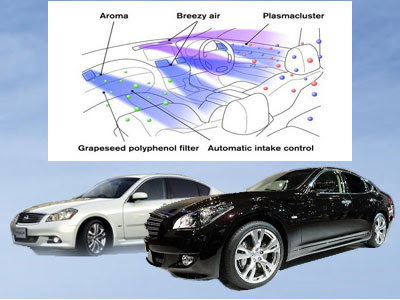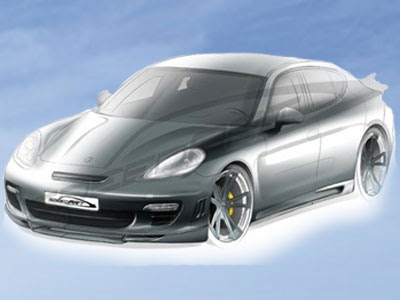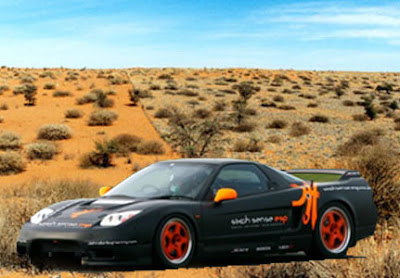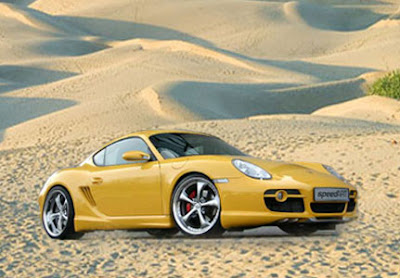Monday, November 30, 2009
Cheap Small Car - Tata Indica Vista - Luxury Car - Latest Small Car
Tata's Indica is most successful car, it has been almost 11years, Tata have sold Indica around 9.4lacs. Its one of the best car.
Later company modified to new version of Indica V2 and the Xeta. Indica Vista sports superior interiors, better quality, and improved performance.
Find out the latest TATA Indica Vista Version and their features.
Tata Indica Vista Aqua 1.2 Safire
5-Seater, 1172 CC, 5 Speed (Manual),
Mileage - 10.8 km/ltr (Petrol)
Tata Indica Vista Aqua 1.3 Quadrajet
5-Seater, 1248 CC, 5 Speed (Manual)
Mileage - 14.7 km/ltr (Diesel)
Tata Indica Vista Aqua 1.4
5-Seater, 1405 CC, 5 Speed (Manual)
Mileage - 12.8 km/ltr (Diesel)
Tata Indica Vista Aura 1.2 Safire
5-Seater, 1172 CC, 5 Speed (Manual)
Mileage - 10.8 km/ltr (Petrol)
Tata Indica Vista Aura 1.3
5-Seater, 1248 CC, 5 Speed (Manual)
Mileage - 14.7 km/ltr (Diesel)
Tata Indica Vista LE Quadrajet
5-Seater, 1248 CC, 5 Speed (Manual)
Mileage - km/ltr (Diesel)
Tata Indica Vista LE Safire
5-Seater, 1172 CC, 5 Speed (Manual)
Mileage - km/ltr (Petrol)
Tata Indica Vista Terra 1.2
5-Seater, 1172 CC, 5 Speed (Manual)
Mileage - 10.8 km/ltr (Petrol)
Tata Indica Vista Terra 1.4 TDI
5-Seater, 1405 CC, 5 Speed (Manual)
Mileage - 12.8 km/ltr (Diesel)
Tata Indica Vista Terra Quadrajet
5-Seater, 1248 CC, 5 Speed (Manual)
Mileage - km/ltr (Diesel)
Prices range from Rs 3,53,000- Rs.5,29,000
Escoriações - 10ª parte
Leia também a 1ª parte, 2ª parte, 3ª parte, 4ª parte, 5ª parte, 6ª parte, 7ª parte, 8ª parte e 9ª parte.
7 – Peças mal ajustadas
A – Folga insuficiente entre pistão e cilindros
Este tipo de anomalia pode causar engripamento e escoriações em um motor pelo rompimento do filme de óleo quando o pistão se dilata.
Constata-s essa condição geralmente por uma área brilhante e polida, acima ou abaixo dos furos do pino (nos pistões de saia interiça) e escoriações nas faces de contato.
B – Muita interferência no pino do pistão
Um ajuste apertado no pino do pistão impede que o pistão se expanda e contraia normalmente, daí resultando folgas insuficientes.
Por isso, quando um pino for instalado sem folga suficiente no furo do pistão ou na bucha da biela, normalmente deverão ser encontradas riscos ou escoriações unicamente nos lados do pistão onde estão os furos dos pinos devendo encontrar-se escoriações e rebarbas nos furos dos pinos.

Escoriações causadas por um pino instalado muito apertado
C - Anéis com folga insuficiente entre pontas.
Os pistões e os anéis se dilatam à medida em que se aquecem atingindo a temperatura de operação do motor.
Por isso, conforme já mencionado anteriormente em “Troca de anéis”, é importante que todos os anéis tenham pelo menos o limite mínimo especificado de folga entre pontas, pois, em caso contrário, as extremidades dos anéis podem encostar-se e causar escoriação, quebra dos anéis ou engripamento do motor.
Uma folga entre pontas inferior ao mínimo especificado pode, por exemplo, ser devida ao fato de estar o cilindro com 0,025 mm (0.001”) menor que a medida prevista, ou pelo fato de usar-se u jogo de anéis incorreto para este motor.
D – Ajuste inadequado das camisas de cilindro
Muitos fabricantes de motores para serviços pesados, fabricam os motores com camisas substituíveis em lugar de cilindros fundidos com o bloco, exibindo dois tipos de camisas: secas e molhadas, como já foi mencionado anteriormente.
O ajuste de camisas secas em um cilindro retificado tem grande influencia na durabilidade e no desempenho dos pistões e anéis de segmento e considerando este fato, os fabricantes despenderam anos e anos, provando e desenvolvendo o ajuste certo das camisas para determinado motor.
Assim sendo, é de estrema importância que o ajuste dessas camisas no bloco seja o mais perfeito possível pois, caso contrario, fatalmente ocorrerão escoriações e engripamento.
Existem três maneiras de ajustar uma camisa incorretamente:
1 – Ajuste muito folgado.
2 – Ajuste muito apertado.
3 – Ajuste em cilindro deformado.
Um ajuste muito folgado da camisa reduz a transferência de calor desta para o bloco, deixando-a superaquecida pelo calor que recebe dos anéis e dos próprios gases da combustão.
Uma combinação dessa situação com a realização de serviços pesados, pode provocar a ruptura do filme de óleo lubrificante e causar escoriações no motor.
Por outro lado, quando se instala uma camisa com muita interferência, além de o próprio bloco poder ficar deformado, o que pode ocorrer é que, como o calor gerado pelo funcionamento do motor faz com que a camisa se dilate, e não existindo condições para que ela se dilate para fora devido à excessiva interferência com o bloco, a camisa acaba se dilatando para dentro, diminuindo de diâmetro.
Com isso, a folga entre camisa e pistão chega a reduzir-se a zero, rompendo o filme de óleo e provocando escoriações e engripamento.
Além disso, dependendo do caso, essa diminuição do diâmetro interno da camisa pode tornar-se permanente.
Quando o motor estiver frio, em determinados pontos, ficará um vazio entre a camisa e o bloco, onde vão se acumular carvão e resina, que irão prejudicar a transferência de calor no local e tornar-se novos pontos de superaquecimento e escoriações.
Quanto à instalação de camisas em cilindros deformados, o que poderá ocorrer é que: ou a camisa se moldará à deformação do cilindro, ficando também deformada e dificultando o assentamento dos anéis, ou não se deformará, formando, no entanto, um contato irregular com as paredes do cilindro, deixando vãos onde se acumularão carvão e resina, causando os problemas descritos anteriormente.
Grandes depósitos de carvão ou resina na parte externa das camisas, sinais de escoriações ou engripamento nos anéis e/ou nas camisas o pontos brilhantes e polidos, evidenciam a deformação ou o esmagamento da camisa devido a irregularidade no cilindro.
E – Desalinhamento de Bielas
Quando as bielas estão desalinhadas, os anéis não tem uma superfície de contato adequada com a parede do cilindro, os pistões se desgastam de forma desigual, o consumo de óleo é anormal e o motor tem maior tendência para engripamento e escoriações.
Identifica-se uma biela desalinhada pelo desgaste irregular do pistão, no sentido diagonal, em pontos opostos, conforme mostra a figura abaixo.

Pistões com desgaste em diagonal
O contato com a parede do cilindro aparece na parte inferior da saia, à esquerda e, na área dos anéis, à direita. Verifica-se, também, um sinal de desgaste, começando à direita na parte superior, descendo em forma diagonal e prolongando-se transversalmente para a esquerda e na parte de baixo da saia.
Portanto, verifique sempre o alinhamento das bielas antes de substituir os anéis, a fim de evitar os problemas acima.
F – Perda da trava do pino
Embora de natureza diferente da escoriação e engripamento como descrito até o momento este é um problema relativamente comum e que e que também provoca riscos e quebras dos anéis, pistões e cilindros.
A avaria do pistão do tipo ilustrado na figura abaixo é devida ao afrouxamento da trava do pino, à quebra da extremidade da trava do pino, ou a um pedaço de metal solto, deixado no interior do pino.

A avaria neste pistão foi causada pela perda da trava do pino.
Em casos desse tipo, devido à inércia, o objeto solto martela o pistão e o cilindro na área do cubo do pino, danificando o pistão enquanto procura sua saída do motor.
Além disso, esses objetes soltos podem passar através do oco do pino, danificando o pistão e a parede do cilindro no lado opostos.
As travas dos pinos podem soltar-se devido a:
1 – Desalinhamento das bielas.
2 – Excessivo jogo axial do virabrequim.
3 – Pinos do pistão muito longos.
4 – Conicidade dos colos do virabrequim.
5 – Cilindro retificado fora de alinhamento.
6 – Pedaços de metal deixando dentro do pino do pistão.
7 – Travas de pinos frouxas.
8 – Uso de trava de pino incorreta.
9 – Travas de pino instalados incorretamente.
7 – Peças mal ajustadas
A – Folga insuficiente entre pistão e cilindros
Este tipo de anomalia pode causar engripamento e escoriações em um motor pelo rompimento do filme de óleo quando o pistão se dilata.
Constata-s essa condição geralmente por uma área brilhante e polida, acima ou abaixo dos furos do pino (nos pistões de saia interiça) e escoriações nas faces de contato.
B – Muita interferência no pino do pistão
Um ajuste apertado no pino do pistão impede que o pistão se expanda e contraia normalmente, daí resultando folgas insuficientes.
Por isso, quando um pino for instalado sem folga suficiente no furo do pistão ou na bucha da biela, normalmente deverão ser encontradas riscos ou escoriações unicamente nos lados do pistão onde estão os furos dos pinos devendo encontrar-se escoriações e rebarbas nos furos dos pinos.

Escoriações causadas por um pino instalado muito apertado
C - Anéis com folga insuficiente entre pontas.
Os pistões e os anéis se dilatam à medida em que se aquecem atingindo a temperatura de operação do motor.
Por isso, conforme já mencionado anteriormente em “Troca de anéis”, é importante que todos os anéis tenham pelo menos o limite mínimo especificado de folga entre pontas, pois, em caso contrário, as extremidades dos anéis podem encostar-se e causar escoriação, quebra dos anéis ou engripamento do motor.
Uma folga entre pontas inferior ao mínimo especificado pode, por exemplo, ser devida ao fato de estar o cilindro com 0,025 mm (0.001”) menor que a medida prevista, ou pelo fato de usar-se u jogo de anéis incorreto para este motor.
D – Ajuste inadequado das camisas de cilindro
Muitos fabricantes de motores para serviços pesados, fabricam os motores com camisas substituíveis em lugar de cilindros fundidos com o bloco, exibindo dois tipos de camisas: secas e molhadas, como já foi mencionado anteriormente.
O ajuste de camisas secas em um cilindro retificado tem grande influencia na durabilidade e no desempenho dos pistões e anéis de segmento e considerando este fato, os fabricantes despenderam anos e anos, provando e desenvolvendo o ajuste certo das camisas para determinado motor.
Assim sendo, é de estrema importância que o ajuste dessas camisas no bloco seja o mais perfeito possível pois, caso contrario, fatalmente ocorrerão escoriações e engripamento.
Existem três maneiras de ajustar uma camisa incorretamente:
1 – Ajuste muito folgado.
2 – Ajuste muito apertado.
3 – Ajuste em cilindro deformado.
Um ajuste muito folgado da camisa reduz a transferência de calor desta para o bloco, deixando-a superaquecida pelo calor que recebe dos anéis e dos próprios gases da combustão.
Uma combinação dessa situação com a realização de serviços pesados, pode provocar a ruptura do filme de óleo lubrificante e causar escoriações no motor.
Por outro lado, quando se instala uma camisa com muita interferência, além de o próprio bloco poder ficar deformado, o que pode ocorrer é que, como o calor gerado pelo funcionamento do motor faz com que a camisa se dilate, e não existindo condições para que ela se dilate para fora devido à excessiva interferência com o bloco, a camisa acaba se dilatando para dentro, diminuindo de diâmetro.
Com isso, a folga entre camisa e pistão chega a reduzir-se a zero, rompendo o filme de óleo e provocando escoriações e engripamento.
Além disso, dependendo do caso, essa diminuição do diâmetro interno da camisa pode tornar-se permanente.
Quando o motor estiver frio, em determinados pontos, ficará um vazio entre a camisa e o bloco, onde vão se acumular carvão e resina, que irão prejudicar a transferência de calor no local e tornar-se novos pontos de superaquecimento e escoriações.
Quanto à instalação de camisas em cilindros deformados, o que poderá ocorrer é que: ou a camisa se moldará à deformação do cilindro, ficando também deformada e dificultando o assentamento dos anéis, ou não se deformará, formando, no entanto, um contato irregular com as paredes do cilindro, deixando vãos onde se acumularão carvão e resina, causando os problemas descritos anteriormente.
Grandes depósitos de carvão ou resina na parte externa das camisas, sinais de escoriações ou engripamento nos anéis e/ou nas camisas o pontos brilhantes e polidos, evidenciam a deformação ou o esmagamento da camisa devido a irregularidade no cilindro.
E – Desalinhamento de Bielas
Quando as bielas estão desalinhadas, os anéis não tem uma superfície de contato adequada com a parede do cilindro, os pistões se desgastam de forma desigual, o consumo de óleo é anormal e o motor tem maior tendência para engripamento e escoriações.
Identifica-se uma biela desalinhada pelo desgaste irregular do pistão, no sentido diagonal, em pontos opostos, conforme mostra a figura abaixo.

Pistões com desgaste em diagonal
O contato com a parede do cilindro aparece na parte inferior da saia, à esquerda e, na área dos anéis, à direita. Verifica-se, também, um sinal de desgaste, começando à direita na parte superior, descendo em forma diagonal e prolongando-se transversalmente para a esquerda e na parte de baixo da saia.
Portanto, verifique sempre o alinhamento das bielas antes de substituir os anéis, a fim de evitar os problemas acima.
F – Perda da trava do pino
Embora de natureza diferente da escoriação e engripamento como descrito até o momento este é um problema relativamente comum e que e que também provoca riscos e quebras dos anéis, pistões e cilindros.
A avaria do pistão do tipo ilustrado na figura abaixo é devida ao afrouxamento da trava do pino, à quebra da extremidade da trava do pino, ou a um pedaço de metal solto, deixado no interior do pino.

A avaria neste pistão foi causada pela perda da trava do pino.
Em casos desse tipo, devido à inércia, o objeto solto martela o pistão e o cilindro na área do cubo do pino, danificando o pistão enquanto procura sua saída do motor.
Além disso, esses objetes soltos podem passar através do oco do pino, danificando o pistão e a parede do cilindro no lado opostos.
As travas dos pinos podem soltar-se devido a:
1 – Desalinhamento das bielas.
2 – Excessivo jogo axial do virabrequim.
3 – Pinos do pistão muito longos.
4 – Conicidade dos colos do virabrequim.
5 – Cilindro retificado fora de alinhamento.
6 – Pedaços de metal deixando dentro do pino do pistão.
7 – Travas de pinos frouxas.
8 – Uso de trava de pino incorreta.
9 – Travas de pino instalados incorretamente.
Sunday, November 29, 2009
Friday, November 27, 2009
Novo CrossFox por R$ 45.550
 Isto mesmo R$ 45.550, é o valor no novo CrossFox, porém ele não traz ar-condicionado. Este item é opcional caso queira instalar este o valor salta para 49.390 reais.
Isto mesmo R$ 45.550, é o valor no novo CrossFox, porém ele não traz ar-condicionado. Este item é opcional caso queira instalar este o valor salta para 49.390 reais.Ele vem de série com direção hidráulica sistema i-System, computador de bordo, direção com regulagem de altura e profundidade além dos vidros e travas elétricas.
Hyundai take on small cars - Types of Hyundaii10 Luxury Cars in India - Cheap Cars in India
Hyundai Motor India Limited is the name which will take all the small cars a tough competition. It is slower than the santro in a straight line, Hyundai i10 have dazzling design.
Types of Hyundai i10
Asta 1.2
Hatchback Type, Small Car,
5-Seater, 1197 CC, 5 Speed (Manual),
Mileage - 12.8 km/ltr (Petrol)
D-Lite
Hatchback Type, Small Car,
5-Seater, 1086 CC, 5 Speed (Manual),
Mileage - 13.2 km/ltr (Petrol)
Sportz 1.2 AT
Hatchback Type, Small Car,
5-Seater, 1197 CC, 4 Speed (Automatic),
Mileage - 10.9 km/ltr (Petrol)
Sportz 1.2
Hatchback Type, Small Car,
5-Seater, 1197 CC, 5 Speed (Manual),
Mileage - 12.8 km/ltr (Petrol)
Era
Hatchback Type, Small Car,
5-Seater, 1086 CC, 5 Speed (Manual),
Mileage - 13.2 km/ltr (Petrol)
Magna
Hatchback Type, Small Car,
5-Seater, 1086 CC, 5 Speed (Manual),
Mileage - 13.2 km/ltr (Petrol)
Magna 1.2
Hatchback Type, Small Car,
5-Seater, 1197 CC, 5 Speed (Manual),
Mileage - 12.8 km/ltr (Petrol)
Magna 1.2 AT
Hatchback Type, Small Car,
5-Seater, 1197 CC, 4 Speed (Automatic),
Mileage - 10.9 km/ltr (Petrol)
Asta 1.2 with Sunroof
Hatchback Type, Small Car,
5-Seater, 1197 CC, 5 Speed (Manual),
Mileage - 12.8 km/ltr (Petrol)
Asta 1.2 AT with Sunroof
Hatchback Type, Small Car,
5-Seater, 1197 CC, 4 Speed (Automatic),
Mileage - 10.9 km/ltr (Petrol)
Thursday, November 26, 2009
2010 Nissan Fuga Priced Sports Sedan The first vehicle to be equipped with the new system “Forest AC”
The interior of Fuga is garnished with a nice blend of leather and and wood grain panels coated with genuine silver powder, which gives them an immaculate mirror finish. It features a new “Forest AC” air conditioning system that creates the refreshing climate, fragrance and natural breezes of a relaxing forest setting.
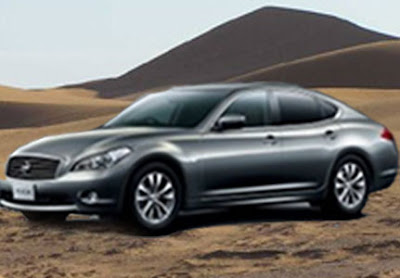
2010 Nissan Fuga Priced Sports Sedan
Nissan has revealed their latest innovation in air conditioning systems - and it's a good one. The "Forest AC" controls the aroma and humidity to help create an optimal interior environment for the occupants. The system uses a number of advanced technologies and is designed to recreate the refreshing climate, fragrance and natural breezes of relaxing forest settings. It was developed based on the results of a joint research study with the Tokyo University of Science on the effects of aroma on human mental activity.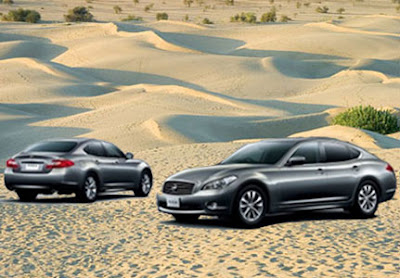

2010 Nissan Fuga Priced Sports Sedan
Along with the air-cleaning and temperature control effect of conventional car air conditioners, the new Forest AC system offers additional control of air flow, humidity, aroma and other ambient factors that can influence the physiological state and senses of the driver and passengers. This is the first automotive system in the world created to make driving more comfortable based on studies of drivers' mental activity.The first vehicle to be equipped with the new system is the 2010 Nissan Fuga.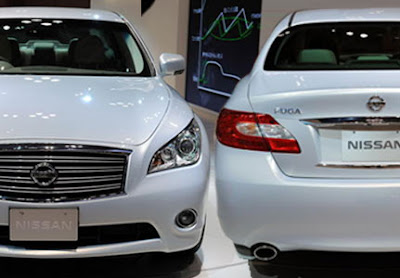

2010 Nissan Fuga Priced Sports Sedan
As we are approaching the new year, manufacturers are announcing new pricing on 2010 updated and new models. One of these new models which was unveiled at this year’s Tokyo Autoshow and received very good media is the Nissan Fuga, an Infiniti based luxury sedan which firstly will go on sale in Japanese domestic market. The car is very well equipped and comes with lots of new features starting at around $45,000.
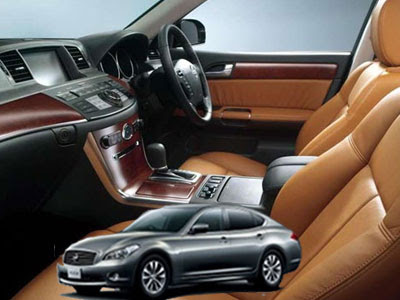
2010 Nissan Fuga Priced Sports Sedan
Since its debut in 2004, the Fuga has been highly praised by customers for its exceptional performance, class-leading interior roominess and a variety of luxurious interior trim options. The new Fuga takes each attribute to a new and higher level.
The new Fuga features a revised model lineup, a redesigned exterior and interior, Nissan’s new VQ35HR and VQ25HR engines and the world’s first*1 Distance Control Assist (Intelligent Pedal) System*2, among other refinements, the combination of which further advances the car’s all-around qualities as a premium sports sedan.

2010 Nissan Fuga Priced Sports Sedan
Living up to its marketing tagline of “SHIFT_luxury,” Fuga transforms the traditional notion of a luxury car. Fuga is available in three grades (GT, GT Type S and GT Type P) for three engine variations (V6 2.5-liter, V6 3.6-liter and V8 4.5-liter). 4WD version is available for 350GT.
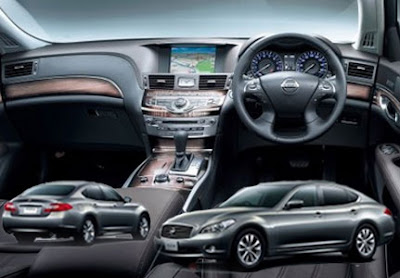
2010 Nissan Fuga Priced Sports Sedan
The new Fuga announces its substantial presence and premium class image with a new “look” featuring redesigned headlights, grille, front and rear bumpers and rear combination lamps. Making even more of a statement is the GT Type S model, with an exterior styling package that includes new side sill spoilers and a “smoky chrome” finish to the inside of the headlights.
Novo CrossFox 2010
 As revistas Quatro Rodas, Auto Esporte e Carro novamente não seguraram a ansiedade e mostraram a cara do novo CrossFox.
As revistas Quatro Rodas, Auto Esporte e Carro novamente não seguraram a ansiedade e mostraram a cara do novo CrossFox.O Novo CrossFox 2010 chega as concessionárias a partir de dezembro. A carinha é a mesma do novo Fox, com os faróis que lembram o Polo europeu.
As modificações no visual tiraram um pouco do fora de estrada deixando-o com um visual mais limpo. Ele não tem o quebra mato dianteiro e o suporte do estepe fica mais escondido. A abertura do porta-malas é automática que é feita após a abertura completa do suporte.
Ele traz de série direção hidráulica, ar-condicionado, vidros e travas elétricas, setas de direção integradas nos retrovisores externos além da regulagem de altura e profundidade do volante. As rodas são de 15 polegadas feitas em aço os rodas de liga são opcionais.
Clique nas fotos para ampliar



Fonte
Wednesday, November 25, 2009
Chevrolet Aveo U-VA - Cheap Luxury Cars - Small Cars in India
Chevrolet Aveo U-VA its a new car for the Indian road, Chevrolet Aveo U-VA have great fuel efficiency.
This is one of the smallest car, have a great looks.
Model of Chevrolet Aveo U-VA are
1.2
1.2LS
1.2LS Techno
1.2LT
Price for Chevrolet Aveo U-VA starts from Rs.4,24,000- 4,68,000, meanwhile the 1.2LT and 1.2 LT go up to Rs.5.5 lakh.
Cheap Small Cars in India - Maruti Suzuki Swift Luxury Car - Diesel Cars
India's most successful cars and its good for the India Road. Small cars like Maruti Suzuki Swift really fun to drive.
Maruti Suzuki Swift Models
LXi
VXi
LDi
Cost of those models Range from Rs.4,17,000 - 4,78,000.
2011 McLaren MP4-12C Super Sports Concept Car pure McLaren, Powered by a twin-turbocharged 3.8 litre, V8 Engine

2011 McLaren MP4-12C
The independent car division based at the McLaren Technology Centre in Woking, England,the McLaren MP4-12C is revealed as the first in a range of high-performance sports cars from McLaren Automotive.The 12C, and future models within the range, will challenge the world's best sports cars, benefiting from the expertise and virtuosity of the McLaren Group.
Through a rich modern history, McLaren's automotive division has already built the world's most critically acclaimed supercar, the McLaren F1 (1993-1998) and the world's best-selling luxury supercar, the Mercedes-Benz SLR McLaren (2003-2009). McLaren Automotive now looks to the future with a new range of revolutionary sports cars.
At its heart, the McLaren MP4-12C features a revolutionary carbon fibre chassis structure, the Carbon MonoCell: the first time a car in this market segment is based around such a strong and lightweight racing car engineering solution and the first time any car has ever featured a one-piece carbon fibre structure.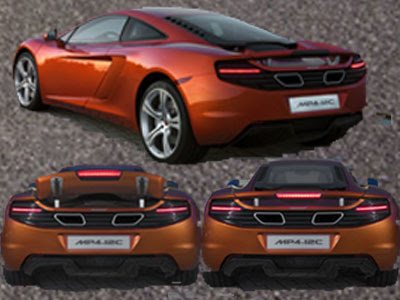

2011 McLaren MP4-12C
Martin Whitmarsh : "McLaren has for years offered a potent mix of race car and road car technologies. This combination of McLaren's performance heritage, and future demands on what is expected of high performance sports cars in the 21st century, gave us a head-start when we embarked on this project. The 12C, and future variants, draws on the spirit of Formula 1 and delivers real-world technological advances."
The first car from the new company, the McLaren MP4-12C, is a high performance two-seat mid-engine model in the 'core' sports car market segment for cars costing between £125,000 and £175,000.It goes on sale through a dedicated, worldwide retailer network in early 2011.
All the parts of the McLaren MP4-12C are bespoke and unique to this car. Everything from the engine right down to the tailor-made switches and buttons is pure McLaren: nothing has come from another manufacturer's parts bin.
The first car from the new company, the McLaren MP4-12C, is a high performance two-seat mid-engine model in the 'core' sports car market segment for cars costing between £125,000 and £175,000.It goes on sale through a dedicated, worldwide retailer network in early 2011.
All the parts of the McLaren MP4-12C are bespoke and unique to this car. Everything from the engine right down to the tailor-made switches and buttons is pure McLaren: nothing has come from another manufacturer's parts bin.
The 12C is powered by a bespoke McLaren 'M838T' 3.8 litre, V8 twin-turbo engine producing around 600bhp, driving through a McLaren seven speed Seamless Shift dual clutch gearbox (SSG). It is targeting not only new standards for power and performance in its sector, but also class-leading fuel economy and CO2 emissions; supported by McLaren's experience of active aerodynamics to aid cooling, grip, handling and road holding.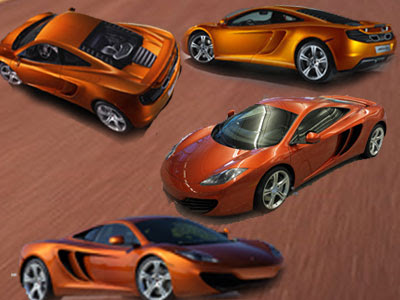

2011 McLaren MP4-12C
"The 12C is all about performance," said Sheriff. "And in McLaren, we have a very broad definition of performance. We don't just look at the traditional one-dimensional parameters like top speed, we focus equally on useable measures such as in-gear acceleration times, braking performance in all conditions, and efficiency of power delivery combined with the lowest possible fuel consumption and CO2 emissions. Sure, 12C is very fast, but it is also the most efficient, most driveable high-performance sports car in the world.
Thorough engineering and market research led to concept development and a clear decision in favour of a mid-engined two door high performance sports car. Intensive work was carried out in the wind tunnel and the driving simulator to ensure that the new car would inherently have superb dynamic qualities.
The McLaren MP4-12C design follows similar principles to McLaren's Formula 1 cars, and the legendary McLaren F1, where everything is for a reason and all lines, surfaces, and details are designed with a job in mind as much as styled. This ensures that the 12C communicates its engineering through its styling and will remain timeless as a piece of automotive design.
"By the time the 12C is launched in 2011 we expect the economic conditions to be much improved. We have already seen significant interest in the car and the supply of the 12C will be relatively scarce; in its first year we plan to produce just 1,000 cars which represents only 3.5 per cent of the 'core' market," explained Antony Sheriff.

2011 McLaren MP4-12C
The McLaren MP4-12C is powered by a twin-turbocharged, 3.8 litre 90° V8 engine - the 'M838T'. This marks the start of a new era in 'core' segment sports cars - smaller capacity, lighter weight, higher efficiency and more economical power units. The engine has the highest specific power output in its segment which, when allied to its low weight carbon composite chassis, delivers exemplary power- and torque-to-weight ratios.The McLaren engine revs to 8,500rpm, has quick transient throttle response and delivers its abundant torque throughout the rev range. A staggering 80 per cent of torque is available at below 2,000rpm, ensuring great driveability and no need to floor the throttle to deliver performance.
The McLaren MP4-12C has been designed around a demanding mechanical package that puts emphasis on aerodynamics, compact dimensions, performance and efficiency, practicality and comfort. Although the design of the 12C was driven by aerodynamics, it aims to remain contemporary and elegant throughout its lifetime as well as distinctive among its peers.
"The 12C design was therefore led by aerodynamics. At McLaren we have been able to use the Formula 1 techniques and the huge expertise that the company has amassed at the pinnacle of the sport," explained Stephenson.
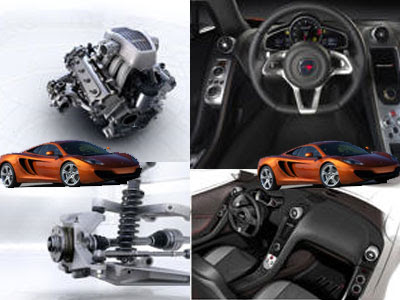
2011 McLaren MP4-12C
Aerodynamic efficiency drove the 12C's design. High downforce helps maintain traction, cornering ability and stability while low drag aids top speed and acceleration. It has a completely flat underbody and smooth upper body surfaces to yield a highly effective drag coefficient and generate very high levels of balanced downforce at high speed.
Labels:
2011,
Concept Car,
McLaren,
Spors Car,
Super Cars,
Super Sports Car
Revelada Strada Sporting 2010
As primeiras imagens oficiais da nova versão Strada Sporting, foram divulgadas pela Fiat na segunda feira (23).
Ela vem com rodas de liga 16 polegadas, spoilers e farol com mascara negra. No interior traz volante de couro com costuras em vermelho, cintos vermelhos e protetores esportivos nos pedais.
Vem com motor 1.8 Flex de 113 cv abastecido com gasolina e 115 cv quando abastecido com álcool.


Estas são as duas fotos disponibilizadas e a Fiat não divulgou ainda valores.
Ela vem com rodas de liga 16 polegadas, spoilers e farol com mascara negra. No interior traz volante de couro com costuras em vermelho, cintos vermelhos e protetores esportivos nos pedais.
Vem com motor 1.8 Flex de 113 cv abastecido com gasolina e 115 cv quando abastecido com álcool.


Estas são as duas fotos disponibilizadas e a Fiat não divulgou ainda valores.
Tuesday, November 24, 2009
2011 Buick Regal Sport Sedan Aesthetics 2.0L Turbo Engine V-6, four-Cylinder.
Armed with turbocharged horsepower the 2011 Buick Regal, a driver-selectable suspension system and a firm, European-tuned chassis, it delivers a driving experience that rivals the best import sport sedans in the segment.
"The 2011 Buick Regal is like nothing you've ever experienced from this brand," said Susan Docherty, general manager of Buick GMC. "The Buick Regal is the next chapter in Buick's transformation and will expand the portfolio to include a sport sedan."
The Buick Regal has already been a success on another continent, in China. It went on sale in December 2008 and more than 64,000 Regals have been sold there. Enthusiastic customers cite its sculpted, flowing design and responsive performance as the top reasons for purchase.
The Buick Regal's sleek design blends the sweeping silhouette and proportions of a coupe in a progressive package that suggests motion from all angles. Great attention to detail complements that aggressive styling, with tailored applications of Buick's signature design cues, such as the waterfall grille, select use of chrome trim and superior fit and finish of the exterior panels.
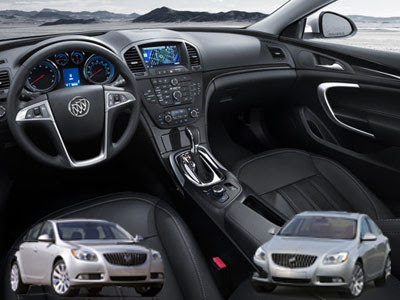
Distinct, uniquely calibrated six-speed automatic transmissions are paired with each engine. Both offer driver shift control that enhances the sporty driving feel of the Buick Regal.
Buick Regal's Interactive Drive Control System chassis technology (available on models with the available 2.0L turbo engine) offers enhanced vehicle stability and greater driving safety. It is designed to change the personality of the car based on the personality of the driver.
The new Buick Regal arrives in the second quarter of 2010, with its sights aimed squarely on competitors like the Acura TSX and Volvo S60. It has a longer wheelbase and greater trunk volume than those vehicles, along with standard features - including a six-speed automatic transmission, 18-inch wheels and OnStar - that aren't offered standard on either competitor.
The Buick Regal's development is rooted in Germany, where the globally led engineering team created the award-winning Opel Insignia - the 2009 European Car of the Year. The Insignia has garnered more than 31 prestigious awards and is the best-selling midsize sedan in Europe. Buick Regal will bring all of Insignia's award-winning design, technology and European-inspired performance capabilities to the American market.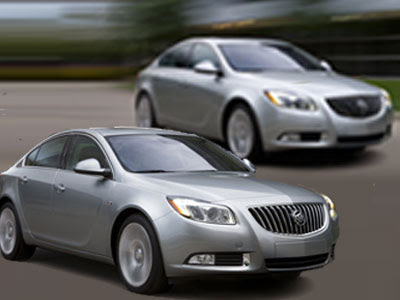

2011 Buick Regal Sport Sedan
The Buick Regal has already been a success on another continent, in China. It went on sale in December 2008 and more than 64,000 Regals have been sold there. Enthusiastic customers cite its sculpted, flowing design and responsive performance as the top reasons for purchase.
The Buick Regal's sleek design blends the sweeping silhouette and proportions of a coupe in a progressive package that suggests motion from all angles. Great attention to detail complements that aggressive styling, with tailored applications of Buick's signature design cues, such as the waterfall grille, select use of chrome trim and superior fit and finish of the exterior panels.
The car's performance-oriented spirit is also conveyed in sleek, sculpted body-side detail and aggressive headlamps that further suggest motion. At the rear, an abbreviated deck and tucked-in body panels are the hallmarks of a contemporary sport sedan, with bold taillamps and their intricate lighting elements reinforcing Buick Regal's attention to detail. Eighteen-inch wheels are standard.
"There is great design harmony between the exterior and interior," said Cafaro. "The feeling of flow and motion carries through in an engaging manner that makes you want to take the Buick Regal out to your favorite twisting road to see what it can do."
The Buick Regal's finely crafted, sporty and well-appointed interior builds on the exceptional attention to detail found in the Enclave and LaCrosse, blending signature styling cues with contemporary sport sedan aesthetics.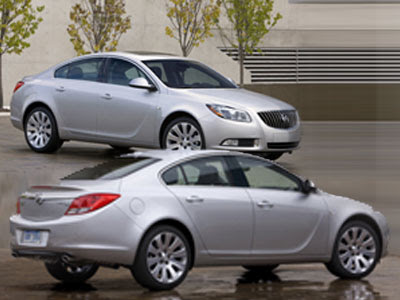
The Buick Regal's finely crafted, sporty and well-appointed interior builds on the exceptional attention to detail found in the Enclave and LaCrosse, blending signature styling cues with contemporary sport sedan aesthetics.

2011 Buick Regal Sport Sedan
Unique with its all-four-cylinder powertrain, the Buick Regal relies on the excellent horsepower-per-liter ratio of the Ecotec engine family to deliver smart, on-demand performance that is also very efficient.
Both the standard 2.4L engine and the available 2.0L turbo use direct injection technology to optimize performance, reduce emissions and maximize fuel efficiency. The 2.4L is the same engine offered in the Buick LaCrosse, but in the smaller, lighter Buick Regal, it delivers more agile performance. The 2.0L turbo cements the sport sedan credibility of the Buick Regal, with on-demand power comparable to a V-6, but the inherent efficiency of a four-cylinder. To ensure responsive power across the rpm range, the 2.0L turbo uses a twin-scroll turbocharger that builds power quickly at lower rpm.
2011 Buick Regal Sport Sedan
Distinct, uniquely calibrated six-speed automatic transmissions are paired with each engine. Both offer driver shift control that enhances the sporty driving feel of the Buick Regal.
Buick Regal's Interactive Drive Control System chassis technology (available on models with the available 2.0L turbo engine) offers enhanced vehicle stability and greater driving safety. It is designed to change the personality of the car based on the personality of the driver.
Monday, November 23, 2009
SpeedART Turbo Porsche Panamera Sports Car Saloon 4.8 liter twin turbo V8 Engine.
German tuner and Porsche specialist SpeedART celibrates its 10th birthday. As a celebration they have created an exhaust package for the Porsche Panamera Turbo.The PS9 package for the German sports saloon ups the ante with numerous aero add-ons and a bevy of performance upgrades. The Sport-Abgas system provides your Panamera with a more raw sound and twenty extra horses.
The Essen Motor Show, which runs from November 28 to December 6 and is best described as Europe’s answer to SEMA, will see Porsche tuning shop, SpeedART, revealing its take on the Panamera.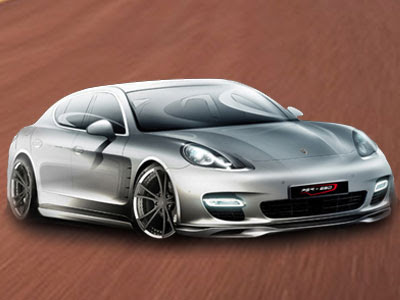
The kit brings the total output to 520bhp. The sprint of the 4.8 liter twin turbo V8 will probably be hit the 4.0 seconds. Top speed will not increase a lot but 303km/h (190mph) isn’t too bad for a four-door sedan.Set to be officially unveiled at the Essen Motor Show, the range topping PS9 features 650 hp and 890 Nm of torque thanks to bigger turbochargers, a sport exhaust system (with a sound switch), a sport catalyst, and a revised ECU. These changes enable the car to accelerate from 0-62 mph in 3.5 seconds, before hitting a top speed in excess of 200 mph. If 650 hp is too hot to handle, the company also offers more modest performance packages that allow the engine to produce 550 and 600 hp.SpeedART claims that the most powerful version of the car accelerates from zero to 100km/h (62mph) in 3.5 seconds and goes on to achieve a top speed in excess of 320km/h or 200mph.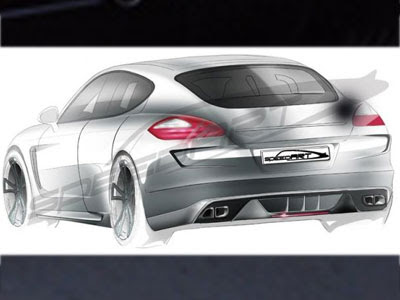
In terms of styling, the PS9 is outfitted with an aerodynamic body kit which consists of a front chin spoiler, hood vents, a rear diffuser, a roof spoiler, a modified rear bumper (with air outlets), and aggressive side skirts. Other design details include 22-inch three-piece 'LSC FORGED' wheels and the aforementioned sport exhaust system (available in polished stainless steel or matt black).Inside, the cockpit will get a SpeedART steering wheel with F1-shift paddles, real carbon-fiber trim and accents, new leather upholstery with colored stitches and a revised instrument panel.At the back, we see a new bumper, and the trapezoidal exhaust pipes. A new rear spoiler will also be mounted.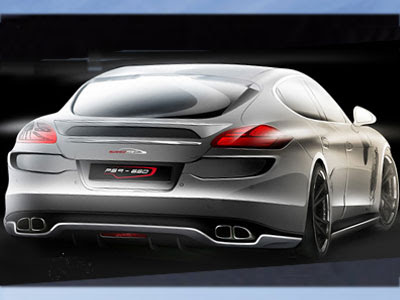
For the interior, SpeedART added a sport steering wheel with F1-shift paddles (which can be outfitted with aluminum-, wood- or carbon fiber inlays), carbon fiber trim, contrast stitching on the door panels and seats, revised instrument dials, and exclusive floor mats.

The kit brings the total output to 520bhp. The sprint of the 4.8 liter twin turbo V8 will probably be hit the 4.0 seconds. Top speed will not increase a lot but 303km/h (190mph) isn’t too bad for a four-door sedan.Set to be officially unveiled at the Essen Motor Show, the range topping PS9 features 650 hp and 890 Nm of torque thanks to bigger turbochargers, a sport exhaust system (with a sound switch), a sport catalyst, and a revised ECU. These changes enable the car to accelerate from 0-62 mph in 3.5 seconds, before hitting a top speed in excess of 200 mph. If 650 hp is too hot to handle, the company also offers more modest performance packages that allow the engine to produce 550 and 600 hp.SpeedART claims that the most powerful version of the car accelerates from zero to 100km/h (62mph) in 3.5 seconds and goes on to achieve a top speed in excess of 320km/h or 200mph.

In terms of styling, the PS9 is outfitted with an aerodynamic body kit which consists of a front chin spoiler, hood vents, a rear diffuser, a roof spoiler, a modified rear bumper (with air outlets), and aggressive side skirts. Other design details include 22-inch three-piece 'LSC FORGED' wheels and the aforementioned sport exhaust system (available in polished stainless steel or matt black).Inside, the cockpit will get a SpeedART steering wheel with F1-shift paddles, real carbon-fiber trim and accents, new leather upholstery with colored stitches and a revised instrument panel.At the back, we see a new bumper, and the trapezoidal exhaust pipes. A new rear spoiler will also be mounted.

For the interior, SpeedART added a sport steering wheel with F1-shift paddles (which can be outfitted with aluminum-, wood- or carbon fiber inlays), carbon fiber trim, contrast stitching on the door panels and seats, revised instrument dials, and exclusive floor mats.
Labels:
PORSCHE,
Porsche Panamera,
Sedan,
SpeedART,
Spors Car,
Sports Saloon,
Turbo
Sunday, November 22, 2009
2009 Honda NSX The Unique Japanese Sports Car Debut at The Season’s Final round at Brands Hatch

2009 Honda NSX
The unique Japanese sportscar Honda NSX has been built by John Danby Racing to comply with the Britcar Production regulations and completed a successful shakedown test at Snetterton in Norfolk last Friday with sportscar racer James Barclay.
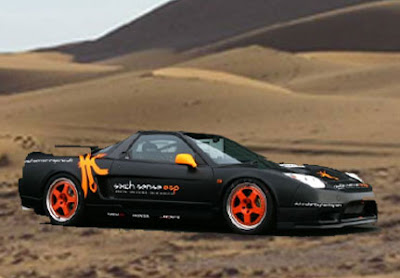
2009 Honda NSX
The Honda NSX features the latest technology gizmos and features innovative engine control and data-logging capabilities including GPS, Fly by Wire and live feed video. High specification custom solutions have also been engineered for the NSX such as dampers and brakes.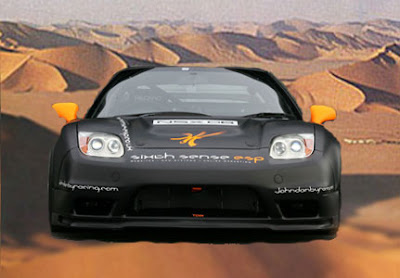

2009 Honda NSX
We gather that you’ll appreciate these photos of John Danby Racing team’s newly developed (and oh-so sizzling hot) Honda NSX racer. The matte black Japanese sportscar was built to comply with the Britcar Production regulations and has already completed a successful shakedown test last Friday ahead of its debut at the season’s final round at Brands Hatch on November 7.
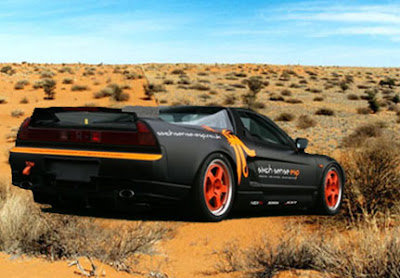
Saturday, November 21, 2009
SRS Aerokit SpeedART The Sports Car Porsche Cayman a Sporty and Elegant.
SRS Aerokit SpeedART The Sports Car Porsche Cayman a Sporty and Elegant.
The SRS Aerokit from the German tuning firm SpeedART is a subtle and stylish way to spruce up the Porsche Cayman or Cayman S.
Unlike many bodykits which radically alter the appearance and persona of the car - sometimes for the good, but all to often for the bad - the SRS Aerokit is extremley in tune with the overall shape of the Cayman.The aerodynamic modifications include a 3-piece front chin spoiler - which provides additional downforce over the front axle, new deeper sideskirts, and an adjustable rear spoiler which has a distinct racing look to it. SpeedART have certainly taken the 'less is more' approach to design, and it's paid off.
The new Boxster and Cayman are significantly more fuel-efficient than their predecessors. The new 2.9-litre Boxer engine sips 8.9 litres of fuel per 100 kilometres (combined) – 11 per cent less than the former models with Tiptronic S. Reducing fuel consumption by 16 per cent to 9.2 litres/100 kilometres, the 3.4-litre versions with PDK offer an even greater saving.
For the first time, both models are available with a Lights Package featuring bi-xenon headlights, dynamic curve lights and LED daytime driving lights. Replacing the foglamps, these light units are made of four LEDs positioned next to one another on the Boxster, while on the Cayman four LEDs are arranged in round light units like the eyes of a dice.
PDK cars’ acceleration is even more dynamic with one of the optional Sports Chrono Packages featuring Launch Control for maximum acceleration from a standing start, while the Race Track Gearshift Strategy offers the fastest possible shifting on the track. With Launch Control, the respective models accelerate from a standstill to 100 km/h another 0.2 seconds faster. (For instance, the Cayman S with PDK and Launch Control accelerates to 100 km/h in 4.9 seconds, while the base Boxster with its new six-speed manual gearbox completes the same exercise in 5.9 seconds.)A new suspension set-up gives the new models a combination of even greater driving dynamics and enhanced comfort. Steering forces have been further reduced, giving the Boxster and Cayman even more agile and spontaneous steering behaviour.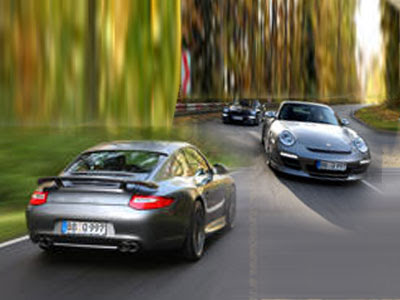
The wheels come in new designs and are half an inch wider on the Boxster and Cayman than in the past in order to accommodate the larger brake system from the S models on the front axle. All Boxster and Cayman models feature the latest generation of Porsche Stability Management (PSM), with two additional functions: Brake Pre-Loading and Brake Assistant.
Whenever the driver lets go of the gas pedal very quickly – which is typical of an upcoming emergency braking manoeuvre – the PSM control unit builds up an appropriate level of pressure on the brakes before the driver even presses down the brake pedal, moving the brake pads slightly towards the discs, which significantly improves brake response and shortens stopping distances accordingly.
Unlike many bodykits which radically alter the appearance and persona of the car - sometimes for the good, but all to often for the bad - the SRS Aerokit is extremley in tune with the overall shape of the Cayman.The aerodynamic modifications include a 3-piece front chin spoiler - which provides additional downforce over the front axle, new deeper sideskirts, and an adjustable rear spoiler which has a distinct racing look to it. SpeedART have certainly taken the 'less is more' approach to design, and it's paid off.
A newly-enlarged 2.9-litre flat-six engine develops 255 bhp in the Boxster and 265 bhp in the Cayman, an increase of 10 and, respectively, 20 bhp over preceding models. The 3.4-litre power unit in the S versions, benefiting from Direct Fuel Injection, now delivers 310 bhp in the Boxster S and 320 bhp in the Cayman S, up by 15 and 25 bhp.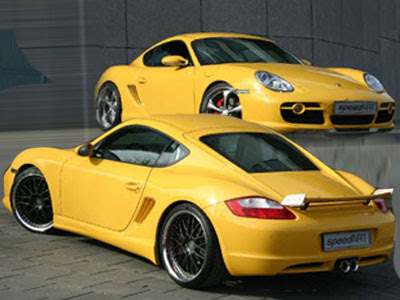

2009 SRS Aerokit SpeedART Porsche Cayman
The new Boxster and Cayman are significantly more fuel-efficient than their predecessors. The new 2.9-litre Boxer engine sips 8.9 litres of fuel per 100 kilometres (combined) – 11 per cent less than the former models with Tiptronic S. Reducing fuel consumption by 16 per cent to 9.2 litres/100 kilometres, the 3.4-litre versions with PDK offer an even greater saving.
For the first time, both models are available with a Lights Package featuring bi-xenon headlights, dynamic curve lights and LED daytime driving lights. Replacing the foglamps, these light units are made of four LEDs positioned next to one another on the Boxster, while on the Cayman four LEDs are arranged in round light units like the eyes of a dice.
The Boxster and Cayman are available for the first time with the seven-speed Porsche-Doppelkupplungsgetriebe, or PDK, which replaces the former Tiptronic S. Equipped with this double-clutch gearbox, the roadster and coupé accelerate to 100 km/h 0.1 seconds faster than with the six-speed manual fitted as standard on all models.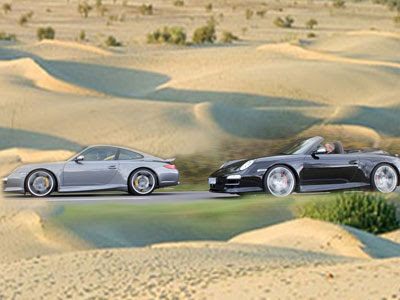

2009 SRS Aerokit SpeedART Porsche Cayman
PDK cars’ acceleration is even more dynamic with one of the optional Sports Chrono Packages featuring Launch Control for maximum acceleration from a standing start, while the Race Track Gearshift Strategy offers the fastest possible shifting on the track. With Launch Control, the respective models accelerate from a standstill to 100 km/h another 0.2 seconds faster. (For instance, the Cayman S with PDK and Launch Control accelerates to 100 km/h in 4.9 seconds, while the base Boxster with its new six-speed manual gearbox completes the same exercise in 5.9 seconds.)A new suspension set-up gives the new models a combination of even greater driving dynamics and enhanced comfort. Steering forces have been further reduced, giving the Boxster and Cayman even more agile and spontaneous steering behaviour.

2009 SRS Aerokit SpeedART Porsche Cayman
The wheels come in new designs and are half an inch wider on the Boxster and Cayman than in the past in order to accommodate the larger brake system from the S models on the front axle. All Boxster and Cayman models feature the latest generation of Porsche Stability Management (PSM), with two additional functions: Brake Pre-Loading and Brake Assistant.
Whenever the driver lets go of the gas pedal very quickly – which is typical of an upcoming emergency braking manoeuvre – the PSM control unit builds up an appropriate level of pressure on the brakes before the driver even presses down the brake pedal, moving the brake pads slightly towards the discs, which significantly improves brake response and shortens stopping distances accordingly.
Friday, November 20, 2009
2010 Bentley Continental Supersports Car is a twin-turbocharged, 6.0 litre W12 engine the fastest, most extreme Bentley ever
2010 Bentley Continental Supersports Car
The Bentley Continental Supersports is the first Bentley model to be designed with some thought given to the environment. Bentleys will never be the most economical or environmentally friendly of vehicles but at least they're recognizing the fact that times are changing.The Continental Supersports began as an 'under the radar' project exploring the possibilities of weight reduction on the Continental GT but with more power and torque.The Bentley Continental Supersports is the fastest and most powerful Bentley ever. It is the extreme Bentley, a muscular two-seater that delivers supercar performance and a highly focused driving experience. The Bentley Continental Supersports is also the first Bentley capable of running on both petrol (gasoline) and biofuel, pioneering the use of FlexFuel technology in the luxury sector. This represents stage one of the company's commitment to make its complete model range compatible with renewable fuels by 2012. Available worldwide from autumn 2009, the Bentley Continental Supersports will be FlexFuel compatible in the majority of markets from launch with North American cars offering the capability by summer 2010, following regulatory approval

2010 Bentley Continental Supersports Car
A largely experimental process crystallised over a period of 24 months into an official new car programme, driven by the passion and enthusiasm of a small group of Bentley engineers and designers.
Powering the Continental Supersports is a twin-turbocharged, 6.0 litre W12 engine which is capable of running on either regular gasoline or E85 biofuel, or a mixture of both. Despite the flex fuel capability the Supersports engine produces a massive 621 horsepower @ 6,000 rpm and 800Nm (590 lb-ft) of torque @ 1,700 rpm - 5,600 rpm. This means the Continental Supersports can reach 60 mph in just 3.7 seconds, 100 mph in 8.9 seconds, and top out at 204 mph.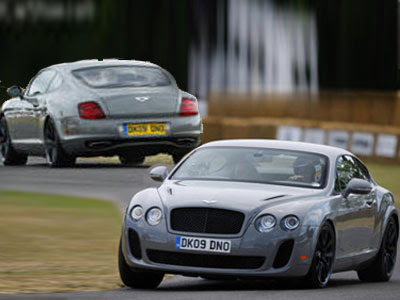

2010 Bentley Continental Supersports Car
The Continental Supersports is fitted with Bentley's carbon-ceramic brakes as standard – the largest and most powerful ever fitted to a production car. The large diameter (420 mm front, 356 mm rear), lightweight discs and eight-piston calipers offer fade-resistant braking performance with minimal disc distortion under high thermal conditions. Overall, the engineering team have achieved a weight reduction of 110 kg (243 lb) compared with the Continental GT Speed.
The evolution of the Bentley Continental Supersports' design is very much a case of 'form following function' with new purposeful sculptural forms signalling the engineering changes beneath the skin.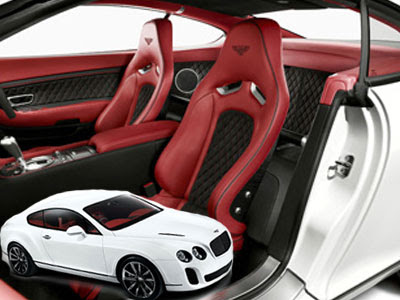

2010 Bentley Continental Supersports Car
The Continental Supersports agility is further sharpened by the 40:60 rear-biased torque split for the all-wheel drive system, a wider rear track, bespoke lightweight 20-inch alloy wheels and a unique electronic stability program.Cosmetic changes to the Bentley Continental Supersports have arisen due to the new powertrain.
The 'Supersports' name is inspired by the original two-seater 3-litre Supersports model introduced in 1925, itself an evolution of the 3-litre Speed. The lightweight, 85 bhp Supersports was the first production Bentley to reach 100 mph and was also renowned for the application of Le Mans-winning race technology.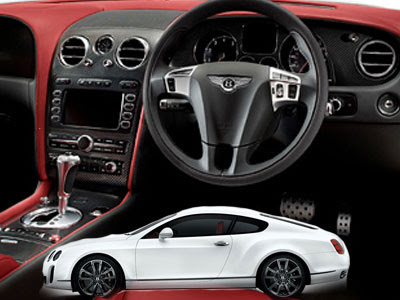

2010 Bentley Continental Supersports Car
Commenting on the new Supersports model, Dr. Franz-Josef Paefgen, Bentley's Chairman and Chief Executive said: "The Bentley Continental Supersports reflects the passion and enthusiasm of Bentley's engineers and designers. This is the fastest, most extreme Bentley ever, dramatically styled to underline its supercar character. Importantly, it also pioneers the use of FlexFuel technology in the luxury sector."
Subscribe to:
Comments (Atom)



